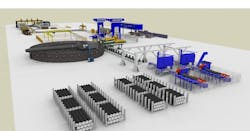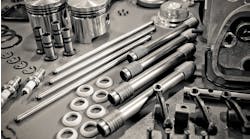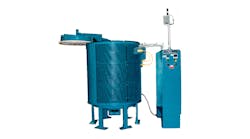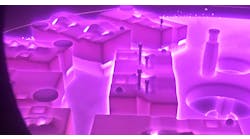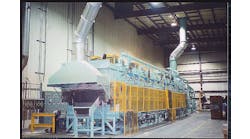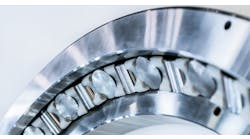No two forging operations are identical, not only because every forger aims to distinguish its products by design and quality, but also by its own performance. This puts forging plant and equipment developers in the position of custom engineering everything — designing, building, and installing production technologies in response to specific objectives. There are no short cuts, and no two projects are quite the same.
Taylor Forge Engineered Systems in Paola, KS, “developed and implemented a plan in 2017 to improve our heat-treating capabilities,” according to George Meyers, materials engineer, “with the goal of maximizing furnace temperature uniformity and product throughput by reducing heat-treating cycle times.” The project was entrusted to Unitherm Furnace LLC.
The Kansas manufacturer is a globally recognized manufacturer of fittings, header assemblies, and other pipeline components, with a production history stretching back almost 100 years. The plant in Paola, one three that Taylor Forge Engineered Systems operates, consists of eight shop buildings and total work space of approximately 250,000 sq. ft. (A second plant in Paola manufactures products for nuclear energy programs.)
“Taylor Forge is committed to enhancing the satisfaction and experience of our customers,” according to Meyers. “Continuous improvement of our processes, and thus the quality of our products, is a key part of that commitment.”
In assigning the heat-treating project to Unitherm Furnace LLC, Taylor Forge Engineered Systems was drawing on nearly 40 years of experience and expertise in developing over 600 thermal-processing systems for commercial heat treaters, forgers, and foundries — and nearly 1,000 system repairs, rebuilds and upgrades.
“The versatility and experience in thermal processing equipment, pyrometry instrumentation, and controls allows us to create innovative designs and build each system to fit a customer’s specific requirements,” according to Unitherm’s Martin Reeves. “These high quality designs, materials and components ensure a long service life and some of the original furnaces built by UF are still running today.”
What Taylor Forge Engineered Systems sought in its RFQ was additional capacity for heating large components involved in forging parts for petrochemical industry handling and processing. “Taylor were looking for another large car-bottom (furnace) to expand their capabilities for large forgings and pipes,” Reeves noted. The furnace needed a working volume of 2,240 ft3 (63.5 m3); a 20-ft long by 8-ft wide (6.1×2.4 m) car bed and, importantly, an internal working height of 14 ft (4.25 m) to accommodate vertical pipe sections.
A working temperature from 800°F (425°C) up to 2,100°F (1,150°C) was required. Reeves reported this was achieved with a total of 20 burners installed in two rows, top and bottom, on either side of the chamber. Total burner power was 20 million BTUs (5,860 kWh) to heat a 70,000-lb (31,750 kg) load.
“The largest goal of this project was to achieve AMS2750E standards, which until recently had not been required by (Taylor Forge Engineered Systems) customers,” emphasized Joe Slattery, general manager at Unitherm Furnaces. Designing a furnace that would address evolving customer requirements and the continuous push for tighter tolerances was a big challenge, he noted. Achieving those requirements, and supplying a system that was able to process 70,000 lbs. of steel and at the same time achieve thermal uniformity without overshooting target temperatures when the furnace is empty, was a significant accomplishment for the furnace builders.
The furnace body was built at Unitherm’s shop in Wentzville, MO, and transported in two sections to Paola, KS. Then, the new car bottom furnace was assembled on-site at Taylor Forge Engineered Systems.
Of course, such a design was specific to the customer’s requirements in respect to its dimensions and operational standards, and drew on the experience and knowledge of Unitherm Furnace personnel from many previous car-bottom furnaces built over the years.
Upon commissioning, the new furnace achieved the required uniformity standards set by the customer at the start of the project. That is, “the requirements of AMS 2750, ASTM A991, and CSA Z245.11 Annex B,” Meyers explained, “and has reduced our heat-treating cycle times while maintaining a temperature uniformity beyond the ±25°F that is typical for our industry.”
Now that the new furnace is in place and running at full design capability, Taylor Forge Engineered Systems is moving forward with its “continuous improvement” effort. A second furnace has been ordered from Unitherm for the same operation. It will be completed by UF in the second half of this year.
But it will not be quite identical to the recent design. It will be even larger. As reported by Reeves, the next installation will have an internal working volume of 40×14×14 ft. (12.2× 4.25×4.25 m / L×W×H); a maximum load of 140,000 lbs. (63,500 kg); and a maximum operating temperature of 2,300°F (1,250°C.) This newer furnace will be heated by 30 burners with a total installed power of 30 million BTUs and comply with AMS 2750 uniformity standards to +/- 25F (~14C.)


